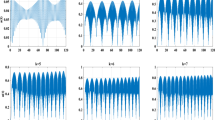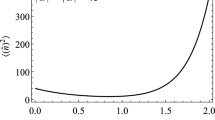Abstract
In this work, interaction of the electromagnetic wave with three-level cascade (\({\Xi }\)), lambda (\({\Lambda }\)), and Vee (\({\text{V}}\)) atomic system has been discussed analytically. The steady-state solutions of optical Bloch equations for all three-level atomic models are obtained to get the absorption and dispersion profile of the probe field. The phenomenon of electromagnetic-induced transparency (EIT) can be observed when the coupling field is applied along with the probe field. The variation of the probe absorption and EIT with the probe decay rate for all three-level atomic models has also been discussed. Furthermore, reduction in the linewidth of EIT window for the lambda and vee models has been shown on increasing the probe decay rate. Numerical results reported in this work may be proved beneficial in high-resolution spectroscopy and atom-based metrology by exploiting the narrow linewidth of the EIT signal.







Similar content being viewed by others

References
J.M. Raimond, Quantum information processing with atoms and cavities. Superlattices Microstruct., 32 (2002) 187–193. https://doi.org/10.1016/S0749-6036(03)00019-3.
H.S. Rawat, S.K. Dubey and V.N. Ojha, Polarization dependence of interferences inside rubidium atomic vapor governing microwave vector E-field metrology. J. Opt. Soc. Am. B, 36 (2019) 3547. https://doi.org/10.1364/josab.36.003547.
A. Monika, H.S. Rawat and S.K. Dubey, RF E-field Sensing Using Rydberg Atom-Based Microwave Electrometry. Mapan – J. Metrol. Soc. India (2020). https://doi.org/10.1007/s12647-020-00404-2.
X. Liu, Z. Jiang, J. Qu, D. Hou and F. Sun, Rabi Resonances in Buffer-Gas-Filled Cs-Vapor Cells for SI-Traceable Microwave Magnetic Field Detection. IEEE Trans. Instrum. Meas., 69 (2020) 1302–1307. https://doi.org/10.1109/TIM.2019.2918514.
Z. Song et al., Rydberg-atom-based digital communication using a continuously tunable radio-frequency carrier. Opt. Express, 27 (2019) 8848. https://doi.org/10.1364/oe.27.008848.
P. Arora et al., Atomic clocks: A brief history and current status of research in India. Pramana - J. Phys., 82 (2014) 173–183. https://doi.org/10.1007/s12043-014-0709-6.
J.L. Hall, Nobel lecture: Defining and measuring optical frequencies. Rev. Mod. Phys., 78 (2006) 1279–1295. https://doi.org/10.1103/RevModPhys.78.1279.
D. Hanneke, S. Fogwell and G. Gabrielse, New measurement of the electron magnetic moment and the fine structure constant. Phys. Rev. Lett., 100 (2008) 1–4. https://doi.org/10.1103/PhysRevLett.100.120801.
C.L. Holloway et al., Broadband Rydberg atom-based electric-field probe for SI-traceable, self-calibrated measurements. IEEE Trans. Antennas Propag., 62 (2014) 6169–6182. https://doi.org/10.1109/TAP.2014.2360208.
M. Scholarworks and R. Jenkins, ‘Measuring Magnetic Field Gradients using Electromagnetically Induced Transparency in Rb Vapor’, Theses, 2019.
S.E. Harris, J.E. Field and A. Imamoǧlu, Nonlinear optical processes using electromagnetically induced transparency. Phys. Rev. Lett., 64 (1990) 1107–1110. https://doi.org/10.1103/PhysRevLett.64.1107.
K.J. Boller, A. Imamolu and S.E. Harris, Observation of electromagnetically induced transparency. Phys. Rev. Lett. (1991). https://doi.org/10.1103/PhysRevLett.66.2593.
J. E. Field, K. H. Hahn, and S. E. Harris Edward L, ‘Observation of Electromagnetically Induced Transparency in Collisionally Broadened Lead Vapor’, 1991.
A.S. Zibrov et al., Experimental demonstration of laser oscillation without population inversion via quantum interference in Rb. Phys. Rev. Lett., 75 (1995) 1499–1502. https://doi.org/10.1103/PhysRevLett.75.1499.
A. Krishna, K. Pandey, A. Wasan and V. Natarajan, High-resolution hyperfine spectroscopy of excited states using electromagnetically induced transparency. Europhys. Lett., 72 (2005) 221–227. https://doi.org/10.1209/epl/i2005-10228-6.
L.V. Hau, Nonlinear optics at low light levels. Phys. Rev. Lett., 82 (1999) 4611–4614. https://doi.org/10.1103/PhysRevLett.82.4611.
S.E. Harris, J.E. Field and A. Kasapi, Dispersive properties of electromagnetically induced transparency. Phys. Rev. A, 46 (1992) 29–32. https://doi.org/10.1103/PhysRevA.46.R29.
M. Xiao, Y.Q. Li, S.Z. Jin and J. Gea-Banacloche, Measurement of dispersive properties of electromagnetically induced transparency in rubidium atoms. Phys. Rev. Lett., 74 (1995) 666–669. https://doi.org/10.1103/PhysRevLett.74.666.
L. Vestergaard Hau, S. E. Harris, Z. Dutton, and C. H. Behroozi, ‘Light speed reduction to 17 metres per second in an ultracold atomic gas’, Nature, vol. 397, no. 6720, pp. 594–598, 1999, doi: https://doi.org/10.1038/17561.
D.F. Phillips, A. Fleischhauer, A. Mair, R.L. Walsworth and M.D. Lukin, Storage of light in atomic vapor. Phys. Rev. Lett., 86 (2001) 783–786. https://doi.org/10.1103/PhysRevLett.86.783.
S.E. Harris and Z.F. Luo, Preparation energy for electromagnetically induced transparency. Phys. Rev. A, 52 (1995) 928–931. https://doi.org/10.1103/PhysRevA.52.R928.
B.S. Ham, Dark resonance based optical switching. J. Mod. Opt., 49 (2002) 2477–2484. https://doi.org/10.1080/0950034021000011301.
E. V. Figueroa Barragan, F. Vewinger, J. Appel, and A. I. . Lvovsky, ‘Adiabatic Transfer of Quantum Optical Information in Atomic Vapor’, vol. 32, no. 19, p. PDP_FC3, 2013, doi: https://doi.org/10.1364/ope.2006.pdp_fc3.
M. Jing et al., Atomic superheterodyne receiver based on microwave-dressed Rydberg spectroscopy. Nat. Phys., 16 (2020) 911–915. https://doi.org/10.1038/s41567-020-0918-5.
S.H. Autler and C.H. Townes, Stark effect in rapidly varying fields. Phys. Rev. (1955). https://doi.org/10.1103/PhysRev.100.703.
H.S. Rawat, S.K. Dubey and V.N. Ojha, Distinction between double electromagnetically induced transparency and double Autler-Townes splitting in RF-driven four-level ladder 87Rb atomic vapor. J. Phys. B At. Mol. Opt. Phys., 51 (2018) 155401. https://doi.org/10.1088/1361-6455/aacdd9.
S. Kumar, H. Fan, H. Kübler, J. Sheng and J.P. Shaffer, Atom-Based Sensing of Weak Radio Frequency Electric Fields Using Homodyne Readout. Sci. Rep. (2017). https://doi.org/10.1038/srep42981.
M. Fleischhauer, A. Imamoglu and P.J. Marangos, Electromagnetically induced transparency. Rev. Mod. Phys., 77 (2005) 633–673. https://doi.org/10.1103/RevModPhys.77.633.
M. Blaauboer, ‘Steady state behaviour in atomic three-level lambda and ladder systems with incoherent population pumping’, 1997.
M. Ranjan Nath, S. Sen, A. Kumar Sen, and G. Gangopadhyay, ‘Dynamical symmetry breaking of lambda-and vee-type three-level systems on quantization of the field modes’, 2008.
S. Sen, T. K. Dey, M. R. Nath, and G. Gangopadhyay, ‘Comparison of Electromagnetically Induced Transparency in lambda, cascade and vee three-level systems’, May 2013, doi: https://doi.org/10.1080/09500340.2014.960019.
F. Le Kien, ‘Density operator and applications in nonlinear optics’, 2008. .
D. Manzano, A short introduction to the Lindblad master equation. AIP Adv. (2020). https://doi.org/10.1063/1.5115323.
V. Gavryusev et al., ‘Density matrix reconstruction of three-level atoms via Rydberg electromagnetically induced transparency’, J. Phys. B At. Mol. Opt. Phys., vol. 49, no. 16, 2016, doi: https://doi.org/10.1088/0953-4075/49/16/164002.
W.Erickson, ‘Electromagnetically Induced Transparency’, Phd Thesis, no. May, 2012.
Acknowledgements
S. S. Nande is thankful to ISERC Department, Visva-Bharati University, Shantiniketan, West Bengal. S. S. Nande is also thankful to the Electromagnetic Metrology section of CSIR-National Physical Laboratory, New Delhi for supporting his visit. Monika Thakran is thankful to Union Grant Commission for Junior Research Fellowship. H. S. Rawat is thankful to Science and Engineering Research Board (SERB), Department of Science and Technology (DST), Government of India, Confederation of Indian Industry (CII), and Rohde & Schwarz India Pvt. Ltd. for the Prime Minister Fellowship for Doctoral Research. Monika Thakran and H. S. Rawat also like to thank Academy of Scientific & Innovative Research (AcSIR) to provide opportunity to work at CSIR-NPL through their Ph.D. Program. Authors are also thankful to the CSIR for FTT project MLP191132 to established Rydberg atom-based sensing at CSIR-NPL.
Author information
Authors and Affiliations
Corresponding author
Additional information
Publisher's Note
Springer Nature remains neutral with regard to jurisdictional claims in published maps and institutional affiliations.
Rights and permissions
About this article
Cite this article
Nande, S.S., Thakran, M., Rawat, H.S. et al. Study of the Electromagnetic-Induced Transparency and its Dependence on Probe Decay for Cascade, Lambda, and Vee Models. MAPAN 37, 347–355 (2022). https://doi.org/10.1007/s12647-021-00510-9
Received:
Accepted:
Published:
Issue Date:
DOI: https://doi.org/10.1007/s12647-021-00510-9



